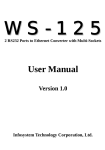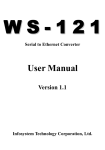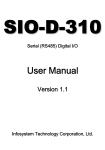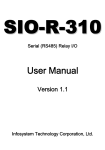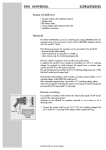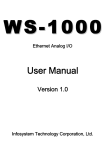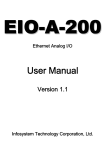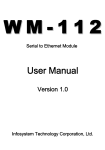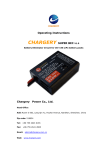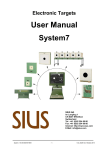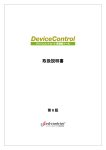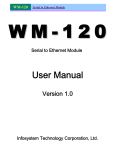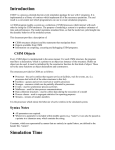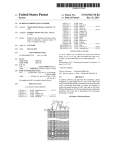Download Drive System SD2 - SIEB & MEYER AG
Transcript
SIEB & MEYER Drive System SD2 DNC 8 Byte Telegram P-TD-0000147.2 2012-11-02 W W Copyright Copyright © 2012 SIEB & MEYER AG. All rights reserved. This manual or extracts thereof may only be copied with the explicit authorization of SIEB & MEYER AG. Trademarks All product, font and company names mentioned in this manual may be trademarks or registered trademarks of their respective companies. SIEB & MEYER worldwide For questions regarding our products and technical problems please contact us. SIEB & MEYER AG Auf dem Schmaarkamp 21 D 21339 Lüneburg Germany Phone: +49 4131 203 0 Fax: +49 4131 203 2000 [email protected] http://www.sieb-meyer.com SIEB & MEYER Asia Co. Ltd. 4 Fl, No. 532, Sec. 1 Min-Sheng N. Road Kwei-Shan Hsiang 333 Tao-Yuan Hsien Taiwan Phone: +886 3 311 5560 Fax: +886 3 322 1224 [email protected] http://www.sieb-meyer.com 2 SIEB & MEYER Shenzhen Trading Co. Ltd. 1st floor, B room of D1 block, DongNan GongMao Building Dongjiaotou Shekou, Houhai Ave, Nanshan District Shenzhen City, 518067 P.R. China Phone: +86 755 2681 1417 / +86 755 2681 2487 Fax: +86 755 2681 2967 [email protected] http://www.sieb-meyer.com SIEB & MEYER USA, LLC 3975 Port Union Road Fairfield, OH 45014 USA Phone: +1 513 563 0860 Fax: +1 513 563 7576 [email protected] http://www.sieb-meyer.com Drive System SD2 - DNC 8 Byte Telegram W Chapter Overview General Information 1 Characteristics of the RS232 Communication 2 Data Types 3 DNC Commands 4 Addressing the Devices 5 Parameterization 6 Telegram Structure 7 Appendix 8 Drive System SD2 - DNC 8 Byte Telegram 3 Chapter Overview 4 W Drive System SD2 - DNC 8 Byte Telegram W Content 1 General Information .......................................................... 7 2 Characteristics of the RS232 Communication .................. 9 2.1 Serial Connection ........................................................................................ 9 2.2 2.3 Parameters of the Serial Interface ............................................................ 10 Time Response ......................................................................................... 10 3 Data Types ...................................................................... 13 3.1 3.2 3.3 3.4 1 Byte Data Types .................................................................................... 2 Byte Data Types .................................................................................... 4 Byte Data Types .................................................................................... 3 Byte Data Types .................................................................................... 4 DNC Commands ............................................................. 15 4.1 General Structure of the Command Interface ........................................... 15 5 Addressing the Devices .................................................. 17 6 Parameterization ............................................................. 19 6.1 6.2 Drive Control ............................................................................................. 19 Bus System ............................................................................................... 19 7 Telegram Structure ......................................................... 21 7.1 Description of the DNC 8 Byte Telegram .................................................. 21 7.2 Description of DNC 16 Byte Telegram ...................................................... 22 7.3 Cyclic Data ................................................................................................ 23 2.1.1 2.1.2 4.1.1 4.1.2 7.1.1 7.1.2 7.2.1 7.2.2 RS232 Connection with SD2 ................................................................................... 9 RS232 Connection with SD2S .............................................................................. 10 13 13 13 14 Command Block .................................................................................................... 15 Reply Block ........................................................................................................... 15 DNC 8 Byte Prompt Telegram .............................................................................. 21 DNC 8 Byte Response Telegram .......................................................................... 21 DNC 16 Byte Prompt Telegram ............................................................................ 22 DNC 16 Byte Response Telegram ........................................................................ 22 7.3.1 7.3.2 PDO Header (Byte 6 and 7) .................................................................................. 23 PDO Data .............................................................................................................. 24 7.4 Acyclic Service Data ................................................................................. 26 8 Appendix ......................................................................... 31 8.A Examples .................................................................................................. 31 7.4.1 7.4.2 7.4.3 7.4.4 7.4.5 8.A.1 8.A.2 8.A.3 Service Control (Byte 17) ...................................................................................... Service Index (Byte 18, 19) ................................................................................... Service Data (Byte 20…23) .................................................................................. Service State (Byte 17) ......................................................................................... Error Codes in the Service Data Channel ............................................................. 27 27 28 28 28 Cyclic Data Communication .................................................................................. 31 Acyclic Data Communication ................................................................................ 33 Calculation of Check Sum ..................................................................................... 35 Drive System SD2 - DNC 8 Byte Telegram 5 Content 6 W Drive System SD2 - DNC 8 Byte Telegram W 1 General Information General Information The DNC 8 Byte protocol is used for diagnosis and parameterization of SD2- drives. A PC can be used for the diagnosis and as parameter interface, interchanging data with the drive via the DNC 8 Byte protocol . The following bus systems are supported for the connection of the drive: < RS232 < RS485 The communication with the SD2 drive is established according to the master-slave method. The PC acts as master and the drive acts as slave. Thus, the drive is only ac‐ tive on request of the master. The data are exchanged as data telegrams. The master sends a command telegram to the slave. When this is received the slave returns a response telegram to the master. The data are only exchanged via the bus system, when the master initiates the ex‐ change. The DNC 8 Byte protocol does not have fixed response times. For this rea‐ son it should only be used for parameterization and diagnosis purposes of the drive. Drive System SD2 - DNC 8 Byte Telegram 7 1 General Information W 1 8 Drive System SD2 - DNC 8 Byte Telegram W 2 Characteristics of the RS232 Communication Characteristics of the RS232 Communication 2 Consider the following descriptions for serial communication with the SD2. 2.1 Serial Connection By means of customary PC data can be exchanged with the drive via the serial inter‐ face. For this purpose a free serial interface of the PC must be connected to the RS232/RS485 interface of the drive. The type of connection depends on the used drive. 2.1.1 RS232 Connection with SD2 Connect the female RJ45 connector X3 at the front panel of the SD2 drive via an RS232 to RS485 converter to a free serial interface of the PC. Connecting cable < < < shielded round cable twisted-pair 8-pole male RJ45 connector ↔ open end Pin assignment on SD2 < 8-pole female RJ45 connector Pin I/O Name 1 – 2 – 3 I/O D+ 4 – 5 – Meaning RS485 interface 6 I/O D− RS485 interface 7 I/O GND Ground 8 I/O GND Ground Drive System SD2 - DNC 8 Byte Telegram 9 W Characteristics of the RS232 Communication 2.1.2 RS232 Connection with SD2S Connect X19 (9-pole male submin D connector) at the front panel of the SD2S-drive to a free serial interface of the PC (9-pole male submin D connector). Connecting cable 2 < < < shielded round cable twisted-pair 9-pole female submin D connector ↔ 9-pole female submin D connector Pin assignment on the device < 9-pole male submin D connector ↔ 9-pole male submin D connector SD2S Name Pin I/O 1 PC I/O Pin – 2 I RxD Receive data from PC O 3 3 O TxD Transmit data to PC I 2 Ground I/O 5 4 5 2.2 Description – I/O GND 6 – 7 – 8 – 9 – Parameters of the Serial Interface The following settings are required for the serial interface: < Baud rate: 57600 bit/s < Data bits: 8 < Parity: None < Stop bits: One < Protocol: none 2.3 Time Response When a DNC command block has been transmitted, the Drive will respond max. 250 µs after having received the last byte of the command block. 10 Drive System SD2 - DNC 8 Byte Telegram W Characteristics of the RS232 Communication Please note that the transmission time depends on the quantity of data. Therefore the PC software drivemaster2 uses a timeout of 1 s to make sure that the serial connection is definitely interrupted. 2 Drive System SD2 - DNC 8 Byte Telegram 11 Characteristics of the RS232 Communication W 2 12 Drive System SD2 - DNC 8 Byte Telegram W 3 Data Types Data Types The communication with the SD2 is carried out by means of DNC commands. These commands allow data exchange with the device via memory blocks. Depending on the DNC command, memory blocks are organized bytewise, wordwise or 3-bytewise. The following applies for a memory block of the length n: < <byte 0, word 0, three byte 0> = byte with the lowest address < <byte n-1, word n-1, three byte n-1 > = byte with the highest address That means: During sequential transmission of the blocks the <byte 0> must be trans‐ mitted first and the <byte n-1> must be transmitted last. The following sections describe the data types known by the SD2 and their bytewise organization. 3.1 1 Byte Data Types One byte is the smallest data format that can be transmitted with an DNC-command. A distinction is drawn between unsigned and signed 1 byte data types: T36_S36_SHORT‐ CARD unsigned 8-bit number (0 … 255) T36_S36_SHORT‐ INT signed 8-bit number (-128 … 127) These data types are equivalent to the C data types unsigned char and signed char. 3.2 2 Byte Data Types 2 byte data types are coded as below: Byte 0 Byte 1 Bit 0 … 7 Bit 8 … 15 A distinction is drawn between unsigned and signed data types: T36_S36_CARDI‐ NAL unsigned 16-bit number (0 … 65535) T36_S36_INTEGER signed 16-bit number (-32768 … 32767) These data types are equivalent to the C data types unsigned short and signed short. 3.3 4 Byte Data Types 4 byte data types are coded as below: Byte 0 Byte 1 Byte 2 Byte 3 Bit 0 … 7 Bit 8 … 15 Bit 16 … 23 bit 24 … 31 A distinction is drawn between unsigned and signed data types: Drive System SD2 - DNC 8 Byte Telegram 13 3 W Data Types T36_S36_LONG‐ CARD unsigned 32-bit number (0 … 4,294,967,295) T36_S36_LONGINT signed 32-bit number (-2,147,483,647 … 2,147,483,647) These data types are equivalent to the C data types unsigned int and signed int. 3 3.4 3 Byte Data Types The devices of the series SD2 partly use 3-byte data items for internal processes. Byte 0 Byte 1 Byte 2 Bit 0 … 7 Bit 8 … 15 Bit 16 … 23 The PC can not process this data type. Since some of the DNC commands use 3-byte data items, they must be represented by the existing PC data types. One 3-byte data item, for example, can be made up of 3 bytes of the type T36_S36_SHORTCARD. Two 3-byte data items can be replaced by three words of the type T36_S36_CARDINAL. And four 3-Byte data items can be represented by three double words of the type T36_S36_LONGCARD. 14 Drive System SD2 - DNC 8 Byte Telegram W 4 DNC Commands DNC Commands In general the DNC communication with the Drive is established by the exchange of data blocks between the DNC master (PC or PLC) and the slave (Drive). A DNC command has the following structure: < Command block (sent from the master to the Drive) < Response block (sent from the Drive to the master) A DNC command is always started by the master. The Drive only can react to the DNC command. The command and response blocks have a different structure and meaning for each DNC command. The command block describes the actual DNC command and may contain so-called sub commands. 4.1 General Structure of the Command Interface Below the general structure of the command and reply telegram is described. 4.1.1 4.1.2 Command Block Offset Type Name Description 0x00 T36_S36_SHORTCARD Zero Start signal for a command transmission: It is always set to zero. 0x01 T36_S36_SHORTCARD Length Protocol length in bytes: It is calculated by the number of the transmitted data, but except of the leading zero, the checksum and the length specification. The smallest length is 3. 0x02 T36_S36_SHORTCARD Dest Destination of the command block: It contains the de‐ sired module number plus 2. 0x03 T36_S36_SHORTCARD Src Transmitter of the commands: Here the value 1 is en‐ tered for the PC or PLC. 0x04 T36_S36_SHORTCARD cmd Command number of the actual DNC command 0x05 T36_S36_SHORTCARD array with a maximum length of 48 bytes Data User data of the command: Depending on the command up to 48 bytes, 24 words or 16 3-byte words can be transmitted. 0x05 + length-3 T36_S36_SHORTCARD Check Check sum: It consists of the ones complement of the sum of the complete data block, except of the check‐ sum. Reply Block Offset Type Name Description 0x00 T36_S36_SHORTCARD Zero Start signal for the reply transmission: It is always set to zero. 0x01 T36_S36_SHORTCARD Length Protocol length in bytes: It is calculated by the number of the transmitted data, but except of the leading zero, the checksum and the length specification. The smallest length is 3. 0x02 T36_S36_SHORTCARD Dest Destination of the reply block: Here the value 1 is en‐ tered for the PC or PLC. Drive System SD2 - DNC 8 Byte Telegram 15 4 W DNC Commands Offset Type Name Description 0x03 T36_S36_SHORTCARD Src Transmitter the reply block: It contains the module num‐ ber of the transmitter plus 2. 0x04 T36_S36_SHORTCARD cmd Number of the executed command: Note, that the most significant bit is additionally set to 1. 0x05 T36_S36_SHORTCARD array with a maximum length of 48 bytes Data User data of the reply block: Depending on the com‐ mand up to 48 bytes, 24 words or 16 3-byte words can be transmitted. 0x05 + length-3 T36_S36_SHORTCARD Check Check sum: It consists of the ones complement of the sum of the complete data block, except of the check sum. 4 16 Drive System SD2 - DNC 8 Byte Telegram W 5 Addressing the Devices Addressing the Devices In order to control the drives via PLC or an appropriate PC program the DNC address‐ es used in the DNC protocol must be known. The DNC drive addresses are derived from the module addresses that are set by means of the address selection switch on each device. Via the module address the software drivemaster2 communicates with the devices. For more information on proper addressing of the modules refer to the docu‐ mentation "drivemaster2 User Manual", chapter "Communication". In the DNC protocol each device (double-axis devices and single-axis devices) has al‐ ways two DNC addresses, that means the master communicates with drive A via the lower DNC address and with drive B via the higher DNC address. Single-axis devices do not have a drive B. Therefore the higher DNC address is not used. The DNC ad‐ dresses 0 and 1 are reserved for the master. For this reason the numbering starts with the DNC address 2. The DNC address of a drive can be calculated from the position of the address selec‐ tion switch on the module by means of the following formula: DNC address drive A = (address selection switch × 2) + 2 DNC address drive B = (address selection switch × 2) + 3 The following figure illustrates the relation of the drive address used in drivemaster2 and the drive address used in the DNC protocol: Fig. 1: Drive addresses in drivemaster2 and in the DNC protocol Drive System SD2 - DNC 8 Byte Telegram 17 5 Addressing the Devices W 5 18 Drive System SD2 - DNC 8 Byte Telegram W 6 Parameterization Parameterization The DNC 8 Byte protocol can be configured via the parameterizing software drivemas‐ ter2. 6.1 Drive Control In order to position via the serial interface RS232 or RS485, you must select the con‐ trol channel and the setpoint channel "DNC 8 Byte Telegram". Thus the drive amplifier expects to be supplied cyclically by reference values (PDOs – process data object) via the serial interface. Acyclic communication is independent of the setpoint channel and works always. 6.2 Bus System 6 When the control channel "DNC 8 Byte Telegram" is parameterized, you can set the properties of the protocol on the page "Bus system". DNC Via this tab page the DNC telegram is parameterized. Baud rate The baud rate of the DNC 8 byte telegram has a fixed value of 57,600 kBaud. Heartbeat When the check box is activated, the communication via the DNC 8 Byte telegram is monitored. During operation the drive now expects to receive prompt telegrams (heart‐ beat messages) from the host periodically. Via the parameter "Heartbeat time" you can enter the time interval between two prompt telegrams. Drive System SD2 - DNC 8 Byte Telegram 19 W Parameterization Heartbeat time The parameter indicates the maximum length of time in milliseconds, in which a heart‐ beat message must be sent to the drive during operation. If the drive does not receive a message within this time, an error is triggered. PDO 0 The tab pages "PDO 0" and "PDO 1" display the assignment of the individual drive ob‐ jects (functions) in the DNC telegram. 6 There is only this one PDO in the DNC 8 Byte Telegram. Receive PDO The Receive PDO displays the received data. The data can not be changed. Transmit PDO The Transmit PDO displays the transmitted data. Here you can set when and in which form the data are sent. The following settings are available: < Disabled: No data are sent. < At receive of RPDO 0: The drive sends the adjacent data, when it is requested for them by a Re‐ ceive PDO from the master. 20 Drive System SD2 - DNC 8 Byte Telegram W Telegram Structure 7 Telegram Structure 7.1 Description of the DNC 8 Byte Telegram Via the command 16 (0x10) "Write CAN Message" of the serial DNC communication PDOs (process data object) are exchanged between master and drive. The user data correspond to the data of the SD2 CAN connection. The telegram has the following structure: < Header (5 bytes) < CAN Header (2 bytes) < Data area (8 bytes) < Check sum (1 byte) 7.1.1 DNC 8 Byte Prompt Telegram Byte Name Value Protocol 1 zero 0 DNC 2 Length 13 DNC 3 dest DNC address DNC 4 Source 1 for PC DNC 5 cmd 0x10 (const) DNC 6 PDO Header PDO Header 0 Cyclic channel 7 PDO Header PDO Header 1 Cyclic channel 8 PDO Data PDO Data 0 Cyclic channel ⋮ PDO Data ⋮ Cyclic channel 15 PDO Data PDO Data 7 Cyclic channel 16 Check(1) Checksum DNC 7 (1) Check = 0xFF - (sum of the bytes 2 to 15) For an example of the check sum calculation see Appendix, p. 35. 7.1.2 DNC 8 Byte Response Telegram Byte Name Value Protocol 1 zero 0 DNC 2 Length 13 (if CAN message available) DNC 3 dest 1 for PC DNC 4 Source DNC address DNC 5 cmd 0x90 (const) DNC 6 PDO Header PDO Header 0 Cyclic channel 7 PDO Header PDO Header 1 Cyclic channel 8 PDO Data PDO Data 0 Cyclic channel ⋮ PDO Data ⋮ Cyclic channel 15 PDO Data PDO Data 7 Cyclic channel Drive System SD2 - DNC 8 Byte Telegram 21 W Telegram Structure Byte 16 Name Value Protocol Check(1) Checksum DNC (1) Check = 0xFF - (sum of the bytes 2 to 15) For an example of the check sum calculation see Appendix, p. 35. 7.2 Description of DNC 16 Byte Telegram The DNC 16 Byte telegram is an extended DNC 8 Byte telegram, in which 8 bytes noncyclic data are added. The protocol structure corresponds to the DNC 8 Byte telegram. The acyclic data are recognized via the length of the protocol (length byte). In the following the telegram structure is described. 7.2.1 DNC 16 Byte Prompt Telegram Byte 7 Name Value Protocol 1 zero 0 DNC 2 Length 21 DNC 3 dest DNC address DNC 4 Source 1 for PC DNC 5 cmd 0x10 (const) DNC 6 PDO Header PDO Header 0 Cyclic channel 7 PDO Header PDO Header 1 Cyclic channel 8 PDO Data PDO Data 0 Cyclic channel ⋮ PDO Data ⋮ Cyclic channel 15 PDO Data PDO Data 7 Cyclic channel 16 Service Control Not used (0) Acyclic service data 17 Service Control Service Control Acyclic service data 18 Service Index Service Index 0 Acyclic service data 19 Service Index Service Index 1 Acyclic service data 20 Service Data Service Data 0 Acyclic service data ⋮ Service Data ⋮ Acyclic service data 23 Service Data Service Data 3 Acyclic service data 24 Check(1) Checksum DNC (1) Check = 0xFF - (sum of the bytes 2 to 23) For an example of the check sum calculation see Appendix, p. 35. 7.2.2 DNC 16 Byte Response Telegram Byte 22 Name Value Protocol 1 zero 0 DNC 2 Length 21 (if CAN message available) DNC 3 dest 1 for PC DNC 4 Source DNC address DNC Drive System SD2 - DNC 8 Byte Telegram W Telegram Structure Byte Name Value Protocol 5 cmd 0x90 (const) DNC 6 PDO Header PDO Header 0 Cyclic channel 7 PDO Header PDO Header 1 Cyclic channel 8 PDO Data PDO Data 0 Cyclic channel ⋮ PDO Data ⋮ Cyclic channel 15 PDO Data PDO Data 7 Cyclic channel 16 Service State Not used (0) Acyclic service data 17 Service State Status Acyclic service data 18 Service Index Service Index 0 Acyclic service data 19 Service Index Service Index 1 Acyclic service data 20 Service Data Service Data 0 Acyclic service data ⋮ Service Data ⋮ Acyclic service data 23 Service Data Service Data 3 Acyclic service data 24 Check(1) Checksum DNC (1) Check = 0xFF - (sum of the bytes 2 to 23) For an example of the check sum calculation see Appendix, p. 35. 7.3 Cyclic Data 7.3.1 PDO Header (Byte 6 and 7) Bit 7 Control telegram Status telegram 0 NMT command bit 0 NMT command bit 0 1 NMT command bit 1 NMT command bit 1 2 Toggle bit Toggle bit 3 PDO selection bit 0 PDO selection bit 0 4 PDO selection bit 1 PDO selection bit 1 5 PDO selection bit 2 PDO selection bit 2 6 0 0 ⋮ 0 0 15 0 0 NMT command The communication of the drive is controlled by the communication state machine (NMT state machine). The state machine can be controlled via the network manage‐ ment (NMT) protocol. The following commands are supported: Command Meaning 0 No action 1 Switches NMT to the state operational 2 Switches NMT to the state pre-operational 3 No action Heartbeat monitoring is only executed in the state "NMT operational". If so, the PDO data can be exchanged. Drive System SD2 - DNC 8 Byte Telegram 23 W Telegram Structure Toggle bit The bit must be toggled (switched over/ inverted) during the parameterized monitoring time (Watchdog timeout), otherwise an error is triggered. Then the axis adapts the tog‐ gled bit again. Thus it can be toggled again. PDO selection The PDO selection defines the way in which the user data will be interpreted. Via the 3 bits you can select PDO 0 to PDO 7. Since currently only PDO 0 is used, the bits Bits 3, 4 and 5 in the PDO Header must be 0. PDO 0 7 7.3.2 Meaning Cyclic process data 1 Not used 2 Not used 3 Not used 4 Not used 5 Not used 6 Not used 7 Not used PDO Data PDO Data contains the user data according to the selected PDO (currently only PDO 0). PDO 0: cyclic exchange of process data Control telegram: Byte Name 8 PDO data 0 9 PDO data 1 10 PDO data 2 11 PDO data 3 12 PDO data 4 13 PDO data 5 14 PDO data 6 15 PDO data 7 Description Control Word Normalized reference speed 0 0 Control word (byte 8 and 9): Bit 24 Name 0 Switch On 1 Enable Voltage 2 Quick Stop 3 Enable Operation 4 Mode 0 5 Mode 1 6 Mode 2 7 Fault Reset Drive System SD2 - DNC 8 Byte Telegram W Telegram Structure Bit Name 8 Hold 9 Reserved 10 Reserved 11 Reserved 12 Reserved 13 Reserved 14 Reserved 15 Reserved For detailed information on the individual control bits and the finite state automaton connected with these please refer to the documentation "SD2_DeviceControl.pdf". The normalized reference speed corresponds to the object SPG_TARGET_VELOCI‐ TY_VL and is a 16 bit value. The value 0x3FFF corresponds to the speed that is en‐ tered in the software drivemaster2 in "Configuration ÿ Motor measurement system ÿ Velocity scaling". Status telegram: Byte Name 8 PDO data 0 9 PDO data 1 10 PDO data 2 11 PDO data 3 12 PDO data 4 13 PDO data 5 14 PDO data 6 15 PDO data 7 Description Status word 7 Normalized actual speed Drive error Normalized actual current Status word (byte 8 and 9): Bit Name 0 Ready to switch on 1 Switched on 2 Operation enabled 3 Fault 4 Voltage enabled 5 Quick Stop 6 Switch on disabled 7 Warning 8 Reserved 9 Remote 10 Target reached 11 Internal limit active 12 Speed zero 13 Max target torque reached 14 Reserved 15 Reserved For detailed information on the individual control bits and the finite state automaton connected with these please refer to the documentation "SD2_DeviceControl.pdf". Drive System SD2 - DNC 8 Byte Telegram 25 Telegram Structure W The actual speed value corresponds to the object VCTRL_VELOCITY_ACTUAL_VA‐ LUE and is a 16 bit value. The value 0x3FFF corresponds to the speed that is entered in the software drivemaster2 in "Configuration ÿ Motor measurement system ÿ Ve‐ locity scaling". A drive error corresponds to the object DEV_CTRL_ERROR_CODE_LATCHED and is a 16 bit value. A list comprising the error messages of the drive is to find in the hard‐ ware documentation of your used hardware. The normalized actual current corresponds to the object ICTRL_IQ_REFERENCE and is a 16 bit value. The value 0x3FFF corresponds to the peak current of the drive. 7.4 Acyclic Service Data In addition to the process data channel (PDO 0) the acyclic channel can be used as service data channel to access all objects in the drive. This service channel is only available in the "DNC 16 Byte telegram". The following accesses are available: < Reading an object: The read access is controlled in the service data channel via 'ServiceFunction = 0 (byte 17)'. Via Index low/high the corresponding object is selected. The result of the read access is returned in the response service data channel. Via array in‐ dex 0…3 a subindex can be transmitted. < Setting an array index: The setting of an array index is controlled in the service data channel 'Service‐ Function = 1 (byte 17)'. Via Index low/high the corresponding object is selected. Via array index 0…3 the array index is transmitted. < Writing an object: The write access is controlled in the service data channel via 'ServiceFunc‐ tion = 2'. Via Index low/high the corresponding object is selected and byte 20… byte 23 contain the according value. Via ServiceLastValidByteIndex the number of valid bytes (minus 1) in this telegram must be defined. 7 Writing of arrays There are max. 32 bit user data available in the service data channel. For this reason only objects with a maximum size of 32 bit can be written. If objects of a larger size shall be written, e.g. arrays, an additional mechanism is nec‐ essary. In order to write arrays at first the corresponding array index must be ad‐ dressed. The array index is addressed in the service data channel via 'ServiceFunc‐ tion = 1' (Set Array Index). The drive acknowledges the telegram by returning the re‐ ceived array index in the actual value telegram. In one of the following reference value telegrams 1 to 4 bytes can be written into the array via the command 'ServiceFunc‐ tion = 2' (Write Object). The array index saved in the device is automatically increased by the written number of bytes. Thus it is possible to write the array consecutively with a new command 'ServiceFunction = 2' (Write Object) in one of the following telegrams. Since there is only one variable available in the drive to save the actual array index, a nested access to two arrays is not possible e.g. write array A, write array B, write array A etc. Reading of arrays During the reading of array objects the array index is transmitted in each reference va‐ lue telegram. For this reason setting an array index is not necessary. The variable saved in the drive is not increased by read access. Therefore the read access to an array does not interrupt the incremental writing of the array. 26 Drive System SD2 - DNC 8 Byte Telegram W Telegram Structure Error during object access When the access to a drive object is faulty (index is not valid, range of values is excee‐ ded, object is not writable etc.), this error is indicated in the actual value telegram via the signal ServiceFault. In addition the detailed error number is returned via Service‐ Return. 7.4.1 Service Control (Byte 17) Service Control: Bit Description 0 – 1 ServiceFunction bit 0 2 ServiceFunction bit 1 3 ServiceLastValidByteIndex bit 0 4 ServiceLastValidByteIndex bit 1 5 – 6 – 7 – ServiceFunction bit 1, 2: < 0 = Read Object < 1 = Set Array Index < 2 = Write Object < 3 = free → fault 7 ServiceLastValidByteIndex bit 3, 4: Number of valid bytes: < 0 = 1 byte < 1 = 2 bytes < 2 = 3 bytes < 3 = 4 bytes Depending on the service function the bytes are interpreted differently in the control telegram. The following table indicates the structure of the data in dependance on the service function. Control telegram: Byte 7.4.2 Control telegram Read Object (0) Write Object (2) Set Array Index (1) 16 Not used – – – 17 Service Control Service Control Service Control Service Control 18 Service Index 0 Index low Index low Not used 19 Service Index 1 Index high Index high Not used 20 Service Data 0 Array Index 0 Byte 0 Array Index 0 21 Service Data 1 Array Index 1 Byte 1 Array Index 1 22 Service Data 2 Array Index 2 Byte 2 Array Index 2 23 Service Data 3 Array Index 3 Byte 3 Array Index 3 Service Index (Byte 18, 19) The Service Index is the object index of the object to be accessed. Drive System SD2 - DNC 8 Byte Telegram 27 W Telegram Structure 7.4.3 Service Data (Byte 20…23) Service Data contains either the data bytes to be written in an object or the subindex for the object access. 7.4.4 Service State (Byte 17) Service State: Bit Description 0 – 1 ServiceFault 2 – 3 – 4 – 5 – 6 – 7 – Depending on the executed service function and the service status the bytes in the sta‐ tus telegram have different meanings. The following table indicates the structure of the data in dependance on the service function and the service status. 7 Status telegram: Byte 7.4.5 28 Status telegram Read Object (0) Write Object (2) Set Array Index (1) 16 Not used – – – 17 Service State Service State Service State Service State 18 Service Index 0 Index low Index low Not used 19 Service Index 1 Index high Index high Not used 20 Service Data 0 Byte 0 / error code Array Index 0 / error code Array Index 0 21 Service Data 1 Byte 1 / error code Array Index 1 / error code Array Index 1 22 Service Data 2 Byte 2 / error code Array Index 2 Array Index 2 23 Service Data 3 Byte 3 / error code Array Index 3 Array Index 3 Error Codes in the Service Data Channel Error code Description 0x00 no error 0x81 or 0x01 Toggle bit not alternated 0x86 or 0x06 CRC error 0x87 or 0x07 No free memory 0x88 or 0x08 Unsupported access to an object 0x89 or 0x09 Attempt to read a write-only object 0x8A or 0x0A Attempt to write in a read-only object 0x8B or 0x0B Object does not exist in the object directory! 0x8C or 0x0C Reserved 0x8D or 0x0D Reserved Drive System SD2 - DNC 8 Byte Telegram W Telegram Structure Error code Description 0x8E or 0x0E General parameter incompatibility reason 0x8F or 0x0F General internal incompatibility in the device 0x90 or 0x10 Access failed due to hardware error 0x91 or 0x11 Data type not correct, length of the service parameter not correct 0x92 or 0x12 Data type not correct, length of the service parameter too long 0x93 or 0x13 Data type not correct, length of the service parameter too short 0x94 or 0x14 Subindex does not exist 0x95 or 0x15 Value range of the parameter exceeded (only for write access) 0x96 or 0x16 Value of the written parameter too high 0x97 or 0x17 Value of the written parameter too low 0x98 or 0x18 Maximum is less than minimum value 0x99 or 0x19 General error 0x9A or 0x1A Data can not be transmitted or saved in the application. 0x9B or 0x1B Data can not be transmitted or saved in the application due to the status of the control. 0x9C or 0x1C Data can not be transmitted or saved in the application due to the reset device. 0x9D or 0x1D Dynamic generation of the object directory not possible or no object directory existing 0x9E or 0x1E Read access denied 0x9F or 0x1F Write access denied Drive System SD2 - DNC 8 Byte Telegram 7 29 Telegram Structure W 7 30 Drive System SD2 - DNC 8 Byte Telegram W Appendix 8 Appendix 8.A Examples 8.A.1 Cyclic Data Communication The following example shows a simple control of the drive at a speed of 50 % of the drive scaling. Start communication < < < < Set communication state machine to "operational". Enable voltage. Set toggle bit to 0. Set speed reference value to 50 %. Send: zero len dest Source cmd header 0 header 1 PDO Data 0 PDO Data 1 PDO Data 2 PDO Data 3 PDO Data 4 0x00 0x0d 0x02 0x01 0x10 0x01 0x00 0x06 0x00 0xFF 0x1f 0x00 PDO Data 5 PDO Data 6 PDO Data 7 psum 0x00 0x00 0x00 0xba ●●● ●●● ●●● 8.A Reply: zero len dest Source cmd header 0 header 1 PDO Data 0 PDO Data 1 PDO Data 2 PDO Data 3 PDO Data 4 0x00 0x0d 0x01 0x02 0x90 0x01 0x00 0x31 0x72 0x00 0x00 0x00 PDO Data 5 PDO Data 6 PDO Data 7 psum 0x00 0x00 0x00 0xbb ●●● ●●● Activate controller Send: zero len dest Source cmd header 0 header 1 PDO Data 0 PDO Data 1 PDO Data 2 PDO Data 3 PDO Data 4 0x00 0x0d 0x02 0x01 0x10 0x01 0x00 0x07 0x00 0xff 0x1f 0x00 PDO Data 5 PDO Data 6 PDO Data 7 psum 0x00 0x00 0x00 0xb9 ●●● Drive System SD2 - DNC 8 Byte Telegram 31 W Appendix Reply: zero len dest Source cmd header 0 header 1 PDO Data 0 PDO Data 1 PDO Data 2 PDO Data 3 PDO Data 4 0x00 0x0d 0x01 0x02 0x90 0x01 0x00 0x33 0x72 0x00 0x00 0x00 PDO Data 5 PDO Data 6 PDO Data 7 psum 0x00 0x21 0x43 0x55 ●●● ●●● ●●● Operation enable < Toggle bit has been toggled. Send: zero len dest Source cmd header 0 header 1 PDO Data 0 PDO Data 1 PDO Data 2 PDO Data 3 PDO Data 4 0x00 0x0d 0x02 0x01 0x10 0x05 0x00 0x0f 0x00 0xff 0x1f 0x00 PDO Data 5 PDO Data 6 PDO Data 7 psum 0x00 0x00 0x00 0xad ●●● ●●● 8.A Reply: zero len dest Source cmd header 0 header 1 PDO Data 0 PDO Data 1 PDO Data 2 PDO Data 3 PDO Data 4 0x00 0x0d 0x01 0x02 0x90 0x05 0x00 0x37 0x72 0xff 0x1f 0x00 PDO Data 5 PDO Data 6 PDO Data 7 psum 0x00 0x21 0x43 0x2f ●●● ●●● Deactivate controller < Toggle bit has been toggled. Send: zero len dest Source cmd header 0 header 1 PDO Data 0 PDO Data 1 PDO Data 2 PDO Data 3 PDO Data 4 0x00 0x0d 0x02 0x01 0x10 0x01 0x00 0x06 0x00 0xff 0x1f 0x00 PDO Data 5 PDO Data 6 PDO Data 7 psum 0x00 0x00 0x00 0xba ●●● 32 Drive System SD2 - DNC 8 Byte Telegram W Appendix Reply: zero len dest Source cmd header 0 header 1 PDO Data 0 PDO Data 1 PDO Data 2 PDO Data 3 PDO Data 4 0x00 0x0d 0x01 0x02 0x90 0x01 0x00 0x31 0x72 0x00 0x00 0x00 PDO Data 5 PDO Data 6 PDO Data 7 psum 0x00 0x21 0x43 0x57 ●●● 8.A.2 ●●● Acyclic Data Communication In addition to the cyclic data there are acyclic data attached to the data protocol. The content of the cyclic part of the data must still be set according to the current operating status of the drive. For this example we consider the drive in the status 'ready for oper‐ ation' but not switched on. Read-out of object 33 (voltage of the bus) Send: zero len dest Source cmd header 0 header 1 PDO Data 0 PDO Data 1 PDO Data 2 PDO Data 3 PDO Data 4 0x00 0x15 0x02 0x01 0x10 0x01 0x00 0x06 0x00 0xff 0x1f 0x00 PDO Data 5 PDO Data 6 PDO Data 7 0 ctrl index 0 index 1 s-data 0 s-data 1 s-data 2 s-data 3 psum 0x00 0x00 0x00 0x00 0x08 0x21 0x00 0x00 0x00 0x00 0x00 0x89 zero len dest Source cmd header 0 header 1 PDO Data 0 PDO Data 1 PDO Data 2 PDO Data 3 PDO Data 4 ●●● 0x00 0x15 0x01 0x02 0x90 0x01 0x00 0x31 0x72 0x00 0x00 0x00 PDO Data 5 PDO Data 6 PDO Data 7 0 ctrl index 0 index 1 s-data 0 s-data 1 s-data 2 s-data 3 psum 0x00 0xec 0xff 0x00 0x01 0x21 0x00 0xbf 0x0c 0x00 0x00 0xdb ●●● ●●● 8.A Reply: ●●● Drive System SD2 - DNC 8 Byte Telegram 33 W Appendix Writing of object 352 (parameter set selection): Send: zero len dest Source cmd header 0 header 1 PDO Data 0 PDO Data 1 PDO Data 2 PDO Data 3 PDO Data 4 0x00 0x15 0x02 0x01 0x10 0x01 0x00 0x06 0x00 0xff 0x1f 0x00 PDO Data 5 PDO Data 6 PDO Data 7 0 ctrl index 0 index 1 s-data 0 s-data 1 s-data 2 s-data 3 psum 0x00 0x00 0x00 0x00 0x0d 0x60 0x01 0x01 0x00 0x00 0x00 0x43 zero len dest Source cmd header 0 header 1 PDO Data 0 PDO Data 1 PDO Data 2 PDO Data 3 PDO Data 4 ●●● 0x00 0x15 0x01 0x02 0x90 0x01 0x00 0x31 0x72 0x00 0x00 0x00 PDO Data 5 PDO Data 6 PDO Data 7 0 ctrl index 0 index 1 s-data 0 s-data 1 s-data 2 s-data 3 psum 0x00 0x21 0x43 0x00 0x00 0x60 0x01 0x01 0x00 0x00 0x00 0xed ●●● ●●● Reply: ●●● 8.A 34 Drive System SD2 - DNC 8 Byte Telegram W 8.A.3 Appendix Calculation of Check Sum Example code: // example receive buffer filled with data from communication example 1: char receiveBuffer[] = {0x00,0x0d,0x01,0x02,0x90,0x01,0x00,0x31,0x72,0x00,0x00,0x00,0x00,0x00,0x00,0xbb}; // this function creates the checksum unsigned char CheckSumm (char * receiveBuffer) { unsigned char Summ = 0; // start value for the checksum int i; // loop counter int length = receiveBuffer[1]; // amount of bytes to create checksum int lastIndex = length + 2; // last valid index for checksum loop for( i=1 ; i<lastIndex ; i++ ) // loop run from "length" byte to last "data" byte { Summ += receiveBuffer[i]; // add new value to last result } return (0xff - Summ); } 8.A // this function compares calculated checksum with received checksum from receive buffer bool CompareCheckSumm(void) { int length = receiveBuffer[1]; // length of checksum data int checksummoffset = length + 2; // index in the array where the checksum is saved if ( receiveBuffer[checksummoffset] == CheckSumm( &receiveBuffer[0] ) ) return true; // compare received checksum with calculated checksum else return false; } Drive System SD2 - DNC 8 Byte Telegram 35 Appendix W 8.A 36 Drive System SD2 - DNC 8 Byte Telegram




































